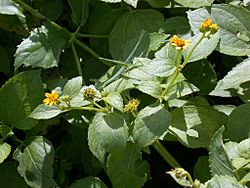Sea daisy facts for kids
Quick facts for kids Sea daisy |
|
|---|---|
 |
|
| Conservation status | |
| Scientific classification | |
| Kingdom: | |
| (unranked): | |
| (unranked): | |
| (unranked): | |
| Order: | |
| Family: | |
| Subfamily: |
Asteroideae
|
| Tribe: | |
| Genus: |
Melanthera
|
| Species: |
M. biflora
|
| Binomial name | |
| Melanthera biflora (L.) Wild.
|
|
| Synonyms | |
|
|
Melanthera biflora, often called the sea daisy, beach daisy, or sea ox-eye, is a type of flowering plant. It belongs to the aster family, which also includes sunflowers and daisies. This plant is tough and grows quickly. It can be found in many warm parts of the world.
Contents
Meet the Sea Daisy!
The sea daisy is a plant that can grow like a vine or spread out over the ground. It is known for being quite hardy. This plant is also one of the first to grow in places where the land has been changed or disturbed.
Where Does It Grow?
Melanthera biflora is a plant that can handle some salt. This means it often grows near the ocean. You can find it in warm, sunny parts of the world. This includes areas around the Indian Subcontinent, Southeast Asia, China, and Queensland in Australia.
It also grows on many islands in the Pacific Ocean. Some of these islands are Fiji, Niue, Tonga, Samoa, and the Cook Islands. While it loves coastal areas, you might also see it growing inland in places that are not well cared for.
What Does It Look Like?
The sea daisy is a strong plant that can be a perennial herb or a small shrub. This means it lives for more than two years. Its stems are long and branched, growing up to 2 meters. They might bend over as they get taller.

The plant can spread across the ground or climb on other plants for support. Its leaves are shaped like an oval and get narrower at the bottom. It produces small, yellow flower heads. These flowers are about 8 to 10 millimeters wide. After the flowers, the plant forms a tight cluster of fruits.
How People Use This Plant
Even though the sea daisy looks a bit rough, its leaves are safe to eat. In Malaysian cuisine, the young shoots are cooked and eaten as a leaf vegetable. In a place called Langkawi, people eat them raw with chilli and a spicy shrimp paste called sambal.
The leaves of Melanthera biflora have also been used in traditional medicine for a long time. People use them to make poultices, which are soft, moist packs put on the body to help with pain. They also make a decoction, which is a liquid made by boiling the plant.
In the Solomon Islands, people on Marovo use the leaves to help with stomachaches. In Fiji, the leaves are used to treat acne. The roots of the plant can be used to help get rid of worms in the body. The flowers can also be used as a purgative, which helps with digestion. This plant is also fed to rabbits.
Images for kids
-
Flowering shrub from Tonga growing along the seashore.




